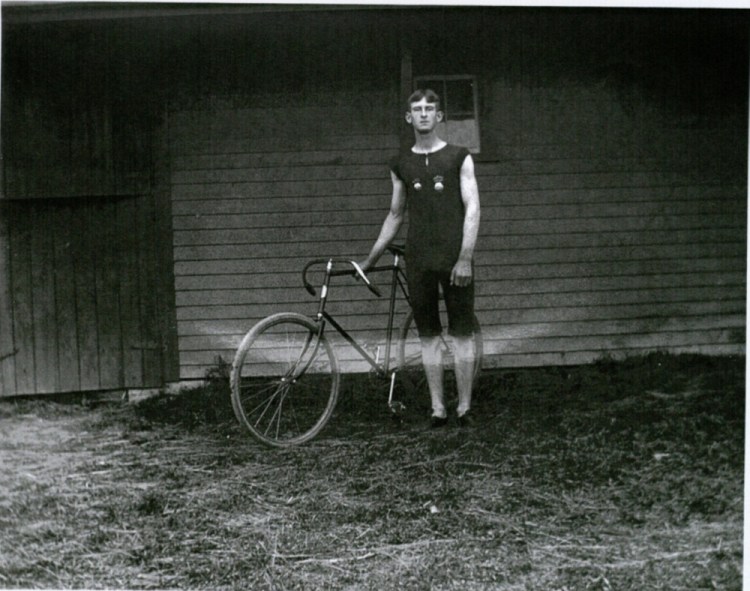Cyclists and historians will gather in Connecticut in June to mark the 150th anniversary of the first recorded bicycle ride in the United States.
Sam Shupe, a young historian and cycling enthusiast from Portland, will join in the festivities at the International Cycling History Conference. He hopes to present a paper there about how bicycling fever in the late 1800s changed Maine. That’s the subject of the thesis he is writing for a doctorate in American Studies at Boston University.
By 1896, there were 40 stores in Portland selling bicycles, and a South Portland factory that produced Lovell Diamond bikes. Bicyclists formed dozens of cycling clubs all over Maine. The Six of One and Half Dozen of the Other Club in Gardiner was so named because “six of its members are maidens and six are matrons,” reported Maine Outing magazine.
Bicyclists were instrumental in lobbying for paved roads. Bicycles gave women new freedom to explore, and many shed long dresses with petticoats for bloomers.
Bicycling also played a key role in making Maine a recreational mecca for both tourists and residents, Shupe said. That will be a central theme in his thesis.
Shupe, 26, says with a smile that it’s ironic that bicycling has become such a big part of his personal and professional life.
“I was an extremely late bloomer with taking the training wheels off,” he admits. “I was terrified of falling.”
By the time he started Portland High School, Shupe was bicycling all over the city. He bought a single-speed bicycle, learned how to take it apart and put it together, and began riding every day, year round. Soon he became known as “a bike guy.”
Shupe has supported himself in recent years partly by driving a pedicab in Boston. He thinks of his bicycle “almost like a fifth appendage,” and feels off kilter when he leaves home without his bike bag.
Shupe described himself as an “uninspired” history major during his first years at the University of Southern Maine. A chance meeting with Maine’s official state historian, Earle Shettleworth, Jr., helped him find his calling.
When Shettleworth learned that Shupe liked bicycles, he showed the young man a leather bicycle guidebook written by Maine cyclists in the 1890s.
Shupe describes it as a “lightbulb moment.” All of a sudden, he realized that he could meld his interests in bicycles and history.
Shettleworth served as his mentor over the next three years. Every Friday, Shupe would visit him at the Maine Historic Preservation Commission in Augusta and look through slides, postcards and other items in the collection.
“He coached me along,” Shupe said.
On one visit, Shupe saw a photo of John Calvin Stevens, the famous Portland architect, on a bicycle. He learned that Stevens was an ardent cyclist and president of the Portland Wheel Club who often bicycled during his business day to get from one place to another. “He was maybe the most influential bicyclist in Maine” in the 1800s, Shupe said.
Shupe researched Stevens’ connection to bicycling and wrote a USM senior thesis on the topic. He was invited to present the paper at the International Cycling History Conference in Paris in 2011.
Shupe says bicycling history has become a “hot” topic. He won the international conference’s 2013 Young Researcher award for his paper about bicycling culture in the Portland suburbs at the turn of the 19th century.
These days, he spends much of his time gathering material for his dissertation at the Maine Historical Society, Boston Public Library, Portland Public Library and Maine State Library and Museum. One of his sources is a weekly bicycling column called Pedal Pushers that once ran in this newspaper.
Shupe is struck by similarities between the issues affecting bicycling in the late 1800s and today.
Then, bicyclists had to contend with dogs and horses. Today’s threats come mostly from motor vehicles. But in both eras, there has been lively debate about how to regulate bicycling.
The Portland neighborhood of Deering, which was a separate town in the late 1800s, had speed limits for bikes and requirements that cyclists stay off sidewalks and use lanterns when biking at night. Shupe said many residents were frustrated that police didn’t do more to enforce bicycling laws. That’s a common refrain today, too.
Shupe hopes to share his research in a way that is approachable for average people as well as academics. One idea is to lead bicycle tours to historic sites such as the place where Portland Wheel Club members gathered for rides and social events.
Shettleworth, the eminent Maine historian, is proud of his protégé’s work.
“The history of bicycling in Maine has been a largely overlooked topic,” Shettleworth said in an email. “Sam is making a significant contribution to our understanding of its role in the state’s social, economic, and sports history.”
Shoshana Hoose is a freelance writer who walks and bicycles in Greater Portland and beyond. Contact her at shoshanahoose@gmail.com.
Copy the Story LinkSend questions/comments to the editors.



Success. Please wait for the page to reload. If the page does not reload within 5 seconds, please refresh the page.
Enter your email and password to access comments.
Hi, to comment on stories you must . This profile is in addition to your subscription and website login.
Already have a commenting profile? .
Invalid username/password.
Please check your email to confirm and complete your registration.
Only subscribers are eligible to post comments. Please subscribe or login first for digital access. Here’s why.
Use the form below to reset your password. When you've submitted your account email, we will send an email with a reset code.